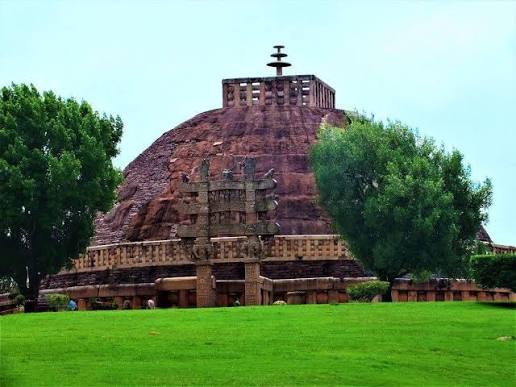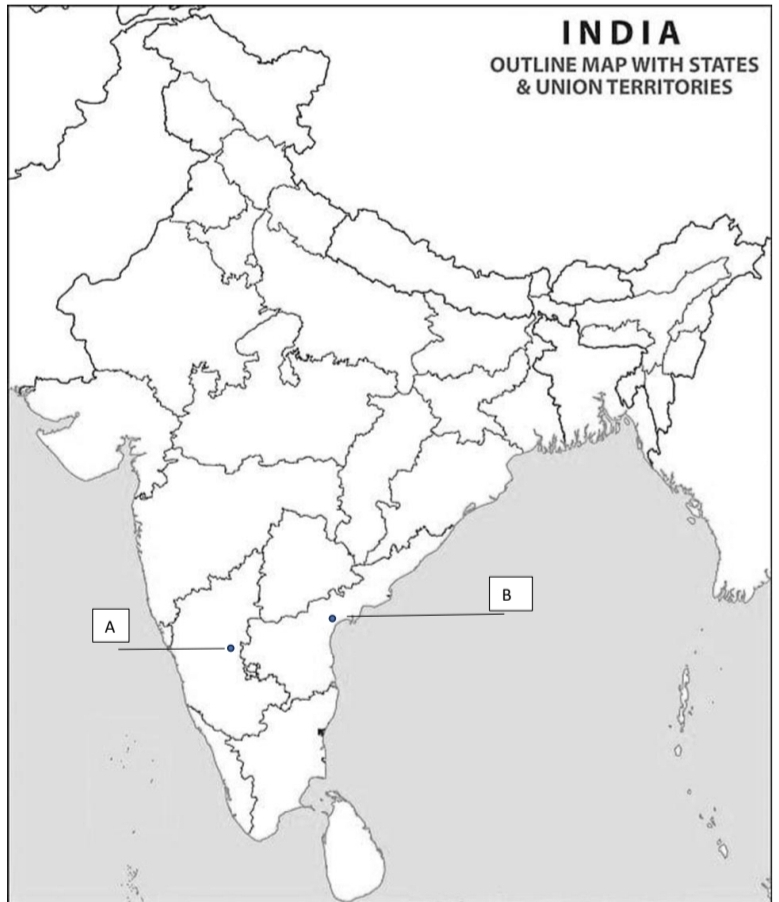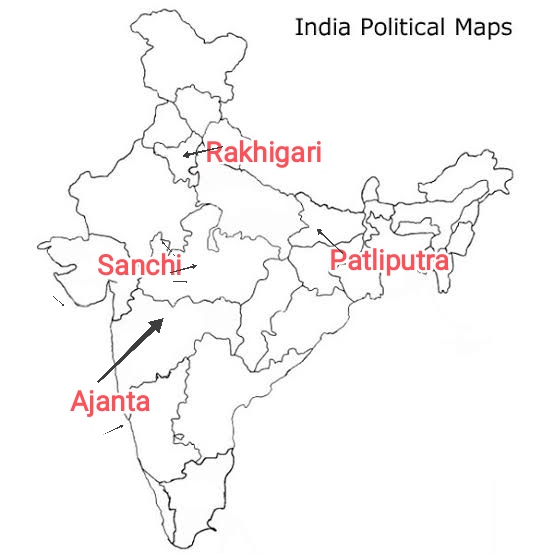complete solved Answer Key for the Mid-Term Practice Paper, Class XII History (2025–26) in English medium.
This will include:
- Section A (MCQs) → correct option + explanation (not just answer)
- Section B (3-mark questions) → 3 point-wise answers, 60–80 words
- Section C (8-mark questions) → detailed structured answers (300–350 words) with internal choice
- Section D (Source-based) → sub-parts solved in CBSE format (1+1+2 marks)
- Section E (Map) → names of sites + answer for visually impaired alternative
Class XII History – Mid-Term Examination (2025–26)
Answer Key (as per CBSE guidelines)
SECTION A (MCQs) (21 × 1 = 21 Marks)
Q1. Which Harappan site is known for its water reservoirs?
A. Mohenjodaro B. Kalibangan
C. Dholavira D. Rakhigarhi
✅ Correct Answer: C. Dholavira
📖 Explanation: Dholavira (Gujarat) is unique for its sophisticated water conservation system with large stone reservoirs and dams, unlike other Harappan sites.
Q2. Megasthenes’ Indica is a source of information for:
A. Gupta empire B. Mauryan empire
C. Vijayanagara empire D. Delhi Sultanate.
✅ B. Mauryan empire
📖 Megasthenes was a Greek ambassador in the court of Chandragupta Maurya. His Indica describes administration, society, flora-fauna, and the city of Pataliputra.
Q3. Which one of the following is NOT correct regarding the Later Vedic period?
A. Agriculture was significant
B. Caste system became rigid
C. Urban centres flourished widely
D. Iron was used
✅ C. Urban centres flourished widely
📖 Later Vedic society was rural and agrarian; towns and large-scale urban centres did not flourish until the 6th century BCE.
Q4. Identify the disciple of Shaikh Nizamuddin Auliya with the help of clues.
० He was a great poet and musician of medieval period.
० He gave a unique form to Chishti sama.
० He introduced qawwali.
A) Baba Farid B) Data Ganj Bakhsh
C) Amir Khusrau D) Ziyauddin
✅ C. Amir Khusrau
📖 He was a poet and musician, disciple of Nizamuddin Auliya, credited with developing qawwali and Hindustani music traditions.
Q5. The Rigveda was composed in:
A) Sanskrit B) Pali C) Prakrit D) Tamil
✅ A. Sanskrit
📖 The Rigveda is the oldest text of Indo-Aryans, composed in Vedic Sanskrit (~1500–1000 BCE).
Q6. Identify the image of stupa

A. Barabar Stupa B. Stupa at Bharhut
C. Sanchi Stupa D. Stupa at Amravati
✅ Correct: C. Sanchi Stupa
📖 Sanchi Stupa (Madhya Pradesh) was commissioned by Ashoka.
or
Note: The following question is for the Visually Impaired Candidates, only in lieu of Q. No. 6 In which of the following texts were Buddha’s teachings compiled?
(A) Uttaradhyayana Sutta (B) Sutta Pitaka
(C) Kalpsutta (D) Rigveda
Answer: B. Sutta Pitaka
Buddha’s teachings are compiled in Sutta Pitaka.
Q7. Al-Biruni’s Kitab-ul-Hind was originally written in:
(A) Arabic (B) Sanskrit (C) Persian (D) Turkish
✅ A. Arabic
📖 Al-Biruni, a Persian scholar, wrote about Indian philosophy, sciences, and customs in Arabic during the 11th century.
Q8. Ibn Battuta was impressed by which Indian practice?
(A) . Caste system (B.) Hospitality
(C). Widow burning (D). Literacy
✅ B. Hospitality
📖 Ibn Battuta admired the Indian tradition of hospitality towards strangers and guests.
Q9. François Bernier compared Mughal India with:
A. Europe B. Africa
C. Ottoman Empire D. Mangol Empire
✅ B. Europe
📖 Bernier compared Mughal agrarian relations with Europe and argued about “oriental despotism.”
Q10. Two statements as Assertion (A) and Reason (R) are given below. Read them carefully and answer the questions that follow:
Assertion (A): Bhakti saints rejected rituals and caste distinctions.
Reason (R): They emphasised direct relationship between devotee and God.
Options:
A. Both Assertion (A) and Reason (R) are correct and Reason (R) is the correct explanation of the Assertion (A).
B. Both Assertion (A) and Reason (R) are correct, but Reason (R) is not the correct explanation of the Assertion (A).
C. Assertion (A) is correct, but Reason (R) is incorrect.
D. Assertion (A) is incorrect, but Reason (R) is correct.:
✅ A. Both (A) and (R) are true, and (R) explains (A).
📖 Bhakti saints rejected rituals and caste, emphasizing a direct bond between devotee and God.
Q11. Adi Granth Sahib was compiled by:
A. Guru Nanak B. Guru Angad
C. Guru Arjan Dev D. Guru Gobind Singh
✅ C. Guru Arjan Dev
📖 In 1604 CE, Guru Arjan Dev compiled the hymns of Sikh Gurus and Bhakti saints into the Adi Granth.
Q12. The sacred centre of Vijayanagara was located at:
A. Hampi B. Sringeri
C. Madurai D. Belur
✅ B. Sringeri
📖 Vijayanagara rulers patronized temples and sacred centres, especially at Sringeri.
Q13. The most powerful rulers of Vijayanagara belonged to:
A. Sangama B. Saluva
C. Tuluva D. Aravidu
✅ C. Tuluva dynasty
📖 Krishnadeva Raya (Tuluva dynasty) is considered the greatest ruler of Vijayanagara.
Q14. Match the following:
(i) Amara-Nayakas → (d) Military chiefs of Vijayanagara
(ii) Krishnadeva Raya → (b) Tuluva dynasty
(iii) Virupaksha Temple → (c) Sacred site of Vijayanagara
(iv) Rama Raya → (a) Chief Minister
A. i-d, ii-b, iii-c, iv-a
B. i-b, ii-c, iii-d, iv-a
C. i-a, ii-d, iii-b, iv-c
D. i-c, ii-a, iii-b, iv-d
✅ Correct Option: A. i-d, ii-b, iii-c, iv-a
Q15. Whose writings on “oriental despotism” influenced western thought?
A. Peter Mundy B. Francois Bernier
C. Duarte Barbosa D. Marco Polo
✅ B. François Bernier
📖 His writings depicted India as stagnant and despotic, influencing Enlightenment thinkers.
Q16. Central system of Mughal agrarian administration was:
A. Ryotwari B. Iqta system
C. Zabti system D. Permanent Settlement
✅ C. Zabti system
📖 Under Akbar, land revenue was assessed and collected through measurement, known as Zabti.
Q17. The Ain-i-Akbari was authored by:
A. Abul Fazl B. Badauni C. Akbar D. Babur
✅ A. Abul Fazl
📖 It forms part of Akbarnama and describes administration, economy, society, and culture.
Q18. The zamindars under the Mughals were:
A. Revenue collectors and local magnates
B. Royal officials only
C. Priests of temples
D. Traders
✅ A. Revenue collectors and local magnates
📖 Zamindars collected revenue, held local power, and often had hereditary rights.
Q19. Jotedars were powerful peasants found mainly in:
A. Punjab B. Awadh C. Bengal D. Deccan
✅ C. Bengal
📖 Jotedars were wealthy peasant landholders who resisted zamindars and controlled rural society.
Q20. Which crop expanded during Mughal economy due to European demand?
A. Cotton B. Indigo C. Wheat D. Rice
✅ B. Indigo
📖 Indigo was highly demanded by Europeans for dyeing cloth, leading to expansion of cultivation.
Q21. The Banjaras were:
A. Pastoralists and traders B. Mughal officials
C. Weavers D. Zamindars
✅ A. Pastoralists and traders
📖 Banjaras were nomadic traders who supplied grain, salt, and other goods to towns and armies.
SECTION B – Short Answer Questions (3 marks each)
Q.22.A – “The Harappan civilisation reveals sophisticated urban planning.” Justify with examples.
Answer:
- Harappan cities like Harappa, Mohenjo-daro, and Dholavira were laid out on grid patterns, with streets intersecting at right angles.
- Cities had advanced drainage systems and sewage networks, showing knowledge of sanitation and public health.
- Standardized brick sizes and public buildings (granaries, baths) indicate planning and uniformity in construction.
Q.22.B – Discuss any three features of Harappan craft production.
Answer:
- Harappans were skilled in bead-making, pottery, and metalwork, producing items for domestic use and trade.
- They used semi-precious stones like carnelian and steatite to make ornaments, showing artistic skill.
- Crafts were standardized, indicating organization and specialization in production.
Q.23 – What do genealogies in early texts tell us about social hierarchies?
Answer:
- Genealogies (like in Puranas and epics) show kings and noble families traced their ancestry to claim legitimacy.
- They reveal caste distinctions, with priests, warriors, merchants, and peasants arranged in a hierarchy.
- Such genealogies indicate social mobility and status, guiding political and religious authority in ancient India.
Q.24 – “Mahabharata is a dynamic text”. Evaluate the statement.
Answer:
- Mahabharata combines history, mythology, and philosophy, making it a living text that adapts to different times.
- Contains moral lessons, such as dharma (duty), justice, and ethics, which are relevant in every age.
- Its stories, like the Kurukshetra war, continue to influence Indian culture, literature, and religion.
Q.25.A – What were the main teachings of Buddha?
Answer:
- Buddha taught the Four Noble Truths: life is suffering; suffering arises from desire; cessation of desire ends suffering; the Eightfold Path leads to liberation.
- Emphasized right conduct, meditation, and wisdom to achieve enlightenment (Nirvana).
- Advocated non-violence, compassion, and moral living, influencing followers’ personal and social life.
Q.26 – How did Ibn Battuta describe Indian cities?
Answer:
- Ibn Battuta praised wealth, trade, and grandeur of Indian cities like Delhi, noting bustling markets and luxury.
- Observed religious tolerance, describing mosques, temples, and festivals.
- Admired urban organization, hospitality, and public works, reflecting prosperity under Delhi Sultanate.
Q.27.A – Describe any three ideas of the Bhakti saints.
Answer:
- Personal devotion to God as the path to salvation, rather than rituals (e.g., Meera Bai, Tulsidas).
- Equality and social reform, rejecting caste distinctions and promoting love for all humans.
- Emphasis on practical spirituality through music, poetry, and moral living, making religion accessible to all.
Q.27.B – How did the Sufi saints spread their message?
Answer:
- Through khanqahs (spiritual centers) and mosques, teaching love, tolerance, and service to humanity.
- Used music, poetry, and storytelling (Qawwalis) to attract people from different backgrounds.
- Practiced inclusive community service, helping the poor and fostering interfaith harmony.
SECTION C – Long Answer Questions (8 marks)
Q.28.A – The amara-nayaka system of the Vijayanagara Empire
Answer (8 points):
- The amara-nayaka system was a military-feudal system introduced by the Vijayanagara rulers to maintain control over their vast empire.
- Nayakas were assigned territories called nadus or policies, responsible for administration, revenue collection, and military defence.
- Nayakas had the authority to maintain a private army, which served the king during wars and protected their territory.
- They were required to pay regular tribute or a share of revenue to the central authority, ensuring loyalty to the emperor.
- The system decentralized administration while preventing rebellion by giving officers limited autonomy under supervision.
- Nayakas were also responsible for maintaining law and order, local infrastructure, and trade regulation in their territories.
- It promoted political stability, rapid military mobilization, and efficient governance across distant regions.
- This system strengthened the power and reach of the Vijayanagara Empire, making it resilient to invasions and internal conflicts.
Q.28.B – Abdur Razzaq and Vijayanagara fortifications
Answer (8 points):
- Abdur Razzaq, a Persian envoy, visited Vijayanagara in the 15th century and was impressed by the empire’s fortifications.
- The city was protected by strong stone walls, ramparts, and fortified gates, showcasing advanced military architecture.
- Moats and watchtowers were built strategically to prevent enemy attacks and to monitor movements.
- Forts were located near rivers and hills, utilizing natural landscapes for defence.
- Gates were heavily guarded, with narrow entrances to slow invading forces.
- The fortifications protected royal palaces, markets, and temples, integrating urban planning with security needs.
- They reflected the empire’s wealth, military strength, and administrative foresight.
- Abdur Razzaq’s account highlights how engineering, architecture, and defence strategies combined to create one of medieval India’s most powerful capitals.
Q.29.A – Role of Ashoka’s Dhamma in unifying the Mauryan Empire
Answer (8 points):
- Dhamma was Ashoka’s moral and ethical policy promoting non-violence, truthfulness, tolerance, and compassion.
- It aimed to create social harmony among the diverse populations of the empire.
- Promoted religious tolerance, allowing different faiths to coexist peacefully.
- Ashoka encouraged obedience, honesty, and respect for elders and teachers, strengthening social cohesion.
- Edicts on rocks and pillars communicated Dhamma across the empire, unifying people under shared moral values.
- Welfare measures like roads, hospitals, wells, and rest houses enhanced the economic and social integration of distant regions.
- Dhamma served as a bond between the emperor and subjects, creating loyalty and a sense of belonging.
- Overall, Ashoka’s Dhamma helped maintain political stability, cultural unity, and social peace in a vast and diverse empire.
Q.29.B – Importance of Megasthenes’ Indica
Answer (8 points):
- Megasthenes, Greek ambassador to Chandragupta Maurya, wrote Indica, an important source for studying ancient India.
- Provides details of administration, including the king, ministers, and bureaucracy.
- Describes cities, urban planning, and population, helping historians understand Mauryan urban life.
- Gives information about trade, commerce, and taxation.
- Discusses social hierarchy, castes, and customs, aiding in understanding the Mauryan society.
- Contains accounts of religious practices and cultural life, including festivals and rituals.
- Though sometimes biased or exaggerated, it can be cross-checked with archaeological evidence.
- Overall, Indica is a primary foreign account, offering critical insights into political, economic, and social aspects of the Mauryan Empire.
Q.30.A – Cultural contributions of Bhakti-Sufi traditions
Answer (8 points):
- Bhakti and Sufi movements emphasized personal devotion to God, transcending caste and religious divisions.
- Bhakti saints like Kabir, Meera Bai, Tulsidas wrote in regional languages, making religious ideas accessible.
- Sufi saints like Khwaja Moinuddin Chishti promoted love, tolerance, and service to humanity.
- These movements fostered religious harmony between Hindus and Muslims.
- Influenced literature, music (bhajans, qawwalis), and devotional poetry.
- Encouraged ethical conduct, charity, and community service among followers.
- Contributed to temple architecture and Sufi shrines, blending artistic traditions.
- Overall, Bhakti-Sufi movements created a shared cultural and spiritual ethos, promoting social cohesion in medieval India.
Q.30.B – Historical significance of Guru Nanak’s teachings
Answer (8 points):
- Guru Nanak founded Sikhism, advocating belief in one God and rejection of ritualism.
- Promoted equality of all humans, challenging caste discrimination.
- Emphasized honest living, charity, and service (seva) to the community.
- Advocated interfaith dialogue, bridging Hindu-Muslim communities.
- Instituted Langar (community kitchen) to promote social equality.
- His teachings encouraged spiritual devotion combined with social responsibility.
- Inspired a distinct Sikh identity through religious and social reform.
- Overall, Guru Nanak’s teachings strengthened ethical, social, and spiritual life, influencing Indian society and history.
SECTION D – Source-Based Questions (4×3 = 12)
Q.31 – Karaikkal Ammaiyar’s Poem
This is an excerpt from a poem by Karaikkal Ammaiyar in which she describes herself: The female Pey (demoness) with… bulging veins, protruding eyes, white teeth and shrunken. stomach, red haired and jutting teeth lengthy shins extending till the ankles, shouts and wails while wandering in the forest. This is the forest of Alankatu, which is the home of our father (Shiva) who dances… with his matted hair thrown own in all eight directions, and with cool limbs.
Source Excerpt:
Describes the poet as a female Pey (demoness) wandering in the forest of Alankatu, Shiva’s abode.
31.1 How has beauty been personified by Karaikkal Ammaiyar?
Answer:
- Karaikkal Ammaiyar presents beauty in a spiritual and ascetic sense, not just physical appearance.
- True beauty is linked to devotion to Shiva rather than conventional attractiveness.
- She portrays herself as ugly externally, but inner beauty lies in piety and surrender to God.
31.2 State the reason behind the poet’s condition
Answer:
- The poet’s bulging veins, protruding eyes, shrunken stomach, and wailing reflect intense ascetic practices.
- She adopts a demon-like appearance to renounce worldly pleasures and dedicate herself fully to Shiva.
31.3 Examine the phrase “With his matted hair thrown in all eight directions.”
Answer:
- This phrase symbolizes Shiva’s cosmic power and universality.
- His energy spreads in all directions, showing omnipresence.
- The poet’s devotion is highlighted by her admiration for Shiva’s divine and boundless nature.
Q.32 – Krishnadeva Raya’s Tank
About a tank constructed by Krishnadeva Raya, Paes wrote:
The king made a tank… at the mouth of two hills so that all the water which comes from either one side or the other collects there; and, besides this, water comes to it from more than three leagues (approximately 15 kilometres) by pipes which run along the lower parts of the range outside. This water is brought from a lake which itself overflows into a little river. The tank has three large pillars handsomely carved with figures; these connect above with. certain pipes by which they get water when they have to irrigate their gardens and rice-fields. In order to make this tank the said king broke down a hill… In the tank I saw so many people at work that there must have been fifteen or twenty thousand men, looking like ants…
32.1 Why did Krishnadeva Raya construct a tank?
Answer:
- To collect water from two hills and irrigate agricultural lands efficiently.
- The tank ensured regular water supply for gardens and rice-fields.
- Demonstrates the king’s focus on agrarian prosperity and public welfare.
32.2 Why did Krishnadeva Raya choose the location at the mouth of two hills?
Answer:
- Strategic location to gather maximum runoff water from both hills.
- Ensured efficient distribution of water through gravity and pipes.
- Reduced construction effort while utilising natural terrain for irrigation.
32.3 In what ways was the water from the tanks used?
Answer:
- Irrigation of rice-fields and gardens.
- Water management for domestic and agricultural needs.
- The tank supported community and economic life by ensuring water availability.
Q.33 – Kabir’s Composition
Here is a composition attributed to Kabir:
Tell me, brother, how can there be
No one lord of the world but two?
Who led you so astray ? God is called by many names:
Names like Allah, Ram, Karim, Keshav, Hari, and Hazrat.
Gold may be shaped into rings and bangles.
Isn’t it gold all the same?
Distinctions are only words we invent…
33.1 How did Kabir describe the ultimate reality?
Answer:
- Kabir described ultimate reality as one formless, universal God, though worshipped under many names (Allah, Ram, Karim, etc.).
- Emphasised that all differences in religion are superficial; the divine is fundamentally the same.
33.2 How does Kabir’s philosophy contribute to a broader understanding of spiritualism?
Answer:
- Rejects ritualistic and sectarian divisions.
- Advocates inner devotion (bhakti) and moral conduct over external rituals.
- Encourages people to focus on universal spiritual truths rather than labels.
33.3 How has Kabir advocated an inclusive and compassionate view of humanity?
Answer:
- Uses the analogy of gold: all human beings are equal regardless of external shape, religion, or caste.
- Promotes tolerance, empathy, and social harmony.
- Calls for elimination of social prejudices and recognition of shared humanity.
SECTION E – Map-Based Questions (1×5 = 5)
34.1 On the outline map of India, locate and label:

- Rakhigrahi: Harappan site in Haryana.
- Patliputra: Capital of Magadha, present-day Patna, Bihar.
- Sanchi: Famous Buddhist site, Madhya Pradesh.
OR
- Ajanta: Buddhist rock-cut caves, Maharashtra.

- A Humpi
- B Vijaynagar
34.2 On the same map, identify centres of Indian National Movement (marked A & B):
Visually Impaired Candidates Version:
- 34.1 (a): Two Harappan sites: Mohenjo-daro and Harappa.
- 34.2 (a): Territory under Ashokan Empire: Magadha.
- 34.2 (b): Kailashnath Temple: Ellora, Maharashtra.
- 34.3: Two kingdoms of ancient India: Maurya and Gupta.







